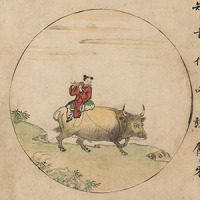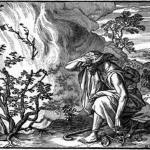
Japan, Kamakura period (1185–1333)
Handscroll; ink and color on paper; Image: 1 ft. 1/4 in. x 20 ft. 6 in. (31.1 x 624.8 cm)
The Metropolitan Museum of Art, New York, Mary Griggs Burke Collection
In the twelfth century a Chinese Zen master, Kuoan Shiyuan wrote a series of poems describing the arc of the spiritual life. He did these poems as comments on a popular series of images describing that path as a child noticing the footprints of an ox in the dirt and begins a journey.
With Kuoan’s poems the whole way of Zen is described.
Alone in the wilderness, lost in the jungle, the boy is searching, searching!
The swelling waters, the far-away mountains, and the unending path;
Exhausted and in despair, he knows not where to go,
He only hears the evening cicadas singing in the maple-woods.
Here we get the great beginning of all spiritual journeys. It starts with noticing something is wrong. Here we can go back to the Buddha’s great noticing in the first of the Four Noble Truths. Human anxiety. Dread. Disquiet. But we also see in this verse the unique perspective of China and the Zen way.
The boy hears those cicadas singing in the evening.
The great lists and profound analysis of India, comes to China and becomes cicadas calling to us. Analysis becomes poetry. Deep intimations become songs.
The next four verses capture aspects of that journey. The verses address when one looks at the various disciplines of Zen, the spiritual technologies of Zen.
All this, when taken together, we come to the sixth Ox Herding picture.
Riding on the animal, he leisurely wends his way home:
Enveloped in the evening mist, how tunefully the flute vanishes away!
Singing a ditty, beating time, his heart is filled with a joy indescribable!
That he is now one of those who know, need it be told?
The following three poems describe the dynamic qualities of Zen’s awakening. In the Ox Herding Pictures they’re a continuation of awakening, ever into further depths. I suggest we can take each of them as complete in themselves. And when we take them all together, we find how our human awakening is now this, now that.
But in the order of the poems, the first of the deep insights accessible to each of us described on the great way sings of an empty circle.
All is empty – the whip, the rope, the man, and the ox:
Who can ever survey the vastness of heaven?
Over the furnace burning ablaze, not a flake of snow can fall:
When this state of things obtains, manifest is the spirit of the ancient master.
Buddhism speaks of emptiness, and sometimes extinction. Here all categories collapse. It is empty. But in Zen that emptiness becomes boundless. The things of the world, whip, rope, human, and ox, are empty. But empty in the very act of presenting. Snow vanishes, but in the face of a burning furnace.
And, this is not the end of the matter.
A next image takes us to a scene of nature. We find the emptiness of things and discover it is boundless. And out of that universes explode, oceans form, mountains rise, and rivers course through valleys.
To return to the Origin, to be back at the Source – already a false step this!
Far better it is to stay at home, blind and deaf, and without much ado;
Sitting in the hut, he takes no cognizance of things outside,
Behold the streams flowing – whither nobody knows; and the flowers vividly red – for whom are they?
And even this is not the end. Not in the Zen way. Where the mysteries that can be described as form and emptiness, take on blood and bone. Out of the boundless rising out of the Great Rift, we emerge. And in our own time, in our own dreaming, we look up to the early morning sky and we see. The morning star kissing the moon.
And our lives become miracles. Our ordinary actions become the stuff of myth. We get up. We follow the needs of our bodies. We sip coffee or tea and we go to work.
Bare-chested and bare-footed, he comes out into the market-place;
Daubed with mud and ashes, how broadly he smiles!
There is no need for the miraculous power of the gods,
For he touches, and lo! The dead trees are in full bloom.
He. She. They.
Our ordinariness, our brokenness, the stuff of our disquiet becomes songs of joy and tunes to which we can dance.
The way and its power.
(The verses are from D. T. Suzuki, Manual of Zen Buddhism, Grove Press, New York, 1960, pp. 150-171.)














